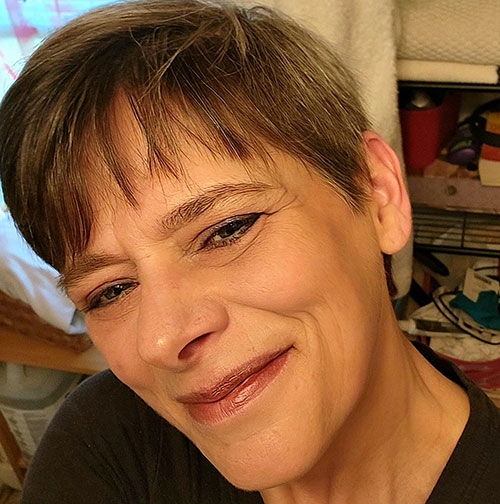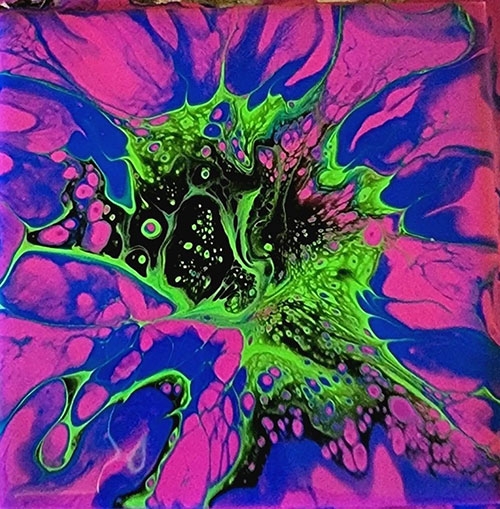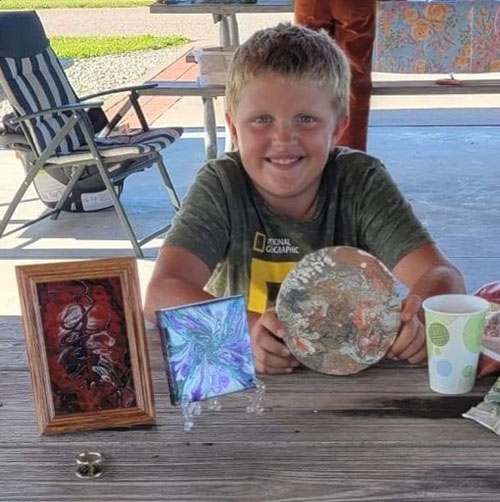You are here
Home ›Lansing artist Sandi Boyd has found a way to process and survive trauma through making art, with “Brave by Design”

Sandi Boyd ...

One of the many “pretties” ... This piece is an example of destructive bloom technique by Lansing artist Sandi Boyd. While acrylic pour painting is a medium beginners can learn and master, there are many techniques involved. Submitted photo.

Serenity Fairy ... “Serenity Fairy” was created by Lansing artist Sandi Boyd using the swipe technique. It is an example of a piece where Boyd combines acrylic paint pouring with the use of “found objects.” Photo by Julie Berg-Raymond.

Young art collector ... Silas Strong is one of Lansing artist Sandi Boyd’s regular patrons. He is the best kind of art collector - he knows what he likes, and that’s what he purchases. In doing so, he is supporting a local artist, developing his own aesthetic sensibility, and building an art collection that is beautiful and meaningful. This photograph was taken at the Lansing Farmer’s Market during one of his recent visits to the event. Submitted photo.
“Creativity takes courage.”
- Henri Matisse
“It’s a choice. You’ve got to choose.”
- Sandi Boyd
by Julie Berg-Raymond
“I love making pretty things – I call them ‘pretties,’” says Lansing artist Sandi Boyd.
Born in Utah and raised in Lansing, Boyd has been interested in art since she was a little girl. “We’ve got a lot of incredibly talented people in my family,” she says.
She had a story published in Highlights magazine - an American children’s magazine that began publication in June 1946 - when she was in sixth grade, and her mom did the illustrations for it. A cousin in Utah does sculpting and photography, and sings. Boyd’s daughter is studying music, and her granddaughter does anime fan art (anime: “hand-drawn and computer animation originating from or associated with Japan,” according to filmstyle.com. “Outside Japan, anime refers specifically to animation from Japan or as a Japanese-disseminated animation style often characterized by colorful graphics, vibrant characters and fantastical themes.”)
Boyd says that making “pretties” is a way of expressing her individuality. It is also - for her, as for Matisse and other creatives - an act of courage. This, then, is a story about how a woman found, in a life-long love of doing art, a way to work through personal trauma; to begin healing, as a survivor of domestic abuse; and to find her way back to herself.
“Every time I make something, it’s one of the ‘uglies’ leaving,” she says.
This also is a story about the business she founded - the design/art studio, Brave by Design - which aims to offer space and opportunity for others to find for themselves what she has found, in making art.
BRAVE BY DESIGN
One of the goals for her business, Boyd says, is bringing more awareness to domestic abuse. Something worth noting, for example, is that there are different forms of abuse; even someone who knows how some of those forms operate can find herself or himself in an abusive situation and not realize it in the beginning.
Prior to marrying the man who would become her abuser, Boyd worked on what is often referred to as the underground railroad for victims of domestic abuse - secret networks that exist throughout the world and that are made up of former victims of abuse, trained counselors, justices of the peace, pastors, lawyers, businesswomen, and others who are sympathetic to the needs of battered women.
“A narcissist will fool you,” Boyd says now, of her own abuser, with whom she was living in another state. “He is an alcoholic, and an abuser of prescription medicines. He never hit me; I was abused in other ways that are worse.” The “bad times” lasted about three years, she says - which, as is typical for people who are suffering domestic abuse, involved gradually being cut off from family and friends. Finally, about eight years ago, she made her escape - and came home to Iowa.
What happened to her is not easy to hear, or to read; but Boyd has clearly come a long way, as a survivor; and she is okay with talking about it. She wants her story to stand as her testimony to what she has gone through, and as affirmation that she survived - and that others can, too.
Boyd recalls the following, about the occasion of her escape: “As I was fighting to get away, I could hear the neighbors tromping down the stairs - they left. They were both sheriff’s deputies; he had convinced them that I was nuts.”
He made her crawl and get a 9mm gun and loaded it in front of her. “All I could do, was pray,” she recalls. “I just said, ‘Your will be done.’ And then I heard, ‘No.’ I fought back, and I knocked him out.” And then she left.
She did not, of course, emerge unscathed. “You CAN have your hair scared white,” she says. “I stumbled around out there for seven years.” She suffered frequent panic attacks, and finally she decided, “I had to find a way to get the ugly out - all the bad things” (she calls them “uglies”) - which led her back to her life-long love of making art. “I started doing the adult coloring books, and that just wasn’t doing it.”
ACRYLIC POUR ART
A little over a year ago, Boyd began watching videos on making acrylic pour art on Facebook. “I was going through a really hard time, and I needed something to relieve the stress,” she says. “I went to Dollar General and got the cheapest starter supplies I could and started pouring.” She purchased cheap craft paint to practice with, along with glue and little cups and sticks.
Acrylic pour painting is a general term for a variety of painting techniques where fluid acrylic paints are poured over the canvas. By using various paint pouring techniques, the artist creates pools or puddles of color, and, sometimes, marble-like effects. Pouring mediums - additives that increase acrylic paint flow - are used, along with other tools to create special effects and to “fix” the finished piece. Techniques include Puddle pour; Dirty pour; Flip cup; Dutch Pour (AirSwipe); Marble Pour Technique; Split cup pour; Balloon dip pour - among several others.
Boyd uses pour techniques on everything from traditional canvas, to found and purchased items like small boxes and craft containers. Some of her pieces are framed; some are made into jewelry, decorator magnets, and other personal and home accessories. She sometimes sells her work at the Lansing Farmer’s Market; her work also can be viewed on her business’ Facebook page, BravebyDesign21.
HEALING VALUE OF ART
Art, of course, is and does a lot of things in the world; and Boyd’s art is beautiful and has its own intrinsic value. But, as she intuited when she turned to her long and deeply held love of making art to help her through a troubled time, it can have therapeutic value, as well. Making art, she says, has been “a way to work through and get past the trauma. I can say, yeah - there is something good about me, no matter what that guy says.”
“The beauty of art is that it is accessible to everyone along with its healing qualities,” says Decorah-based art therapist Karen Misseldine. “Art-making gives the opportunity for making choices, having control and the power to destroy and create and engage in a therapeutic process of catharsis, problem-solving and mastery. Art offers ways to tell our story over and over metaphorically, expressively and visually until the layers of negative self-beliefs are released along with ruminating thoughts and reliving traumatic memories.”
As an art therapist, Misseldine is trained in studio art and has a working knowledge of what different art materials and creative processes may evoke in the individuals they work with. “We carefully use this knowledge with gentle guidance and therapeutic safety in mind,” she says. “It’s a dynamic therapy that involves the whole self; the body, mind and nervous system engaging the creative part of the brain that is not readily accessible through traditional talk therapy alone.” Art therapy, she says, helps a person develop “a lifelong relationship with the creative process itself - building self-confidence and an interdependence with their own creative life force.”
While not an art therapist, Boyd wants to help foster this same kind of empowerment in her community. “I don’t want ‘Brave by Design’ to be just about me, or just to make money,” she says. Her dream is to “have a space where people can come in and do their stuff. The only thing they would have to do, is some kind of work - teach a class, or even sweep the floor.”
She is looking into grant opportunities and hopes to open a place where people can come in and work on their own projects and make art in a communally supportive and encouraging setting. She is talking with Maryann Baldwin, owner of Lansing Office Works, about doing a “pop-up” class, or possibly a sip n’ pour event, at that facility.
For now, though, she says, “I’m super-excited to finally get my home studio set up - if people want to come in and learn (pour painting techniques), they can.” To make an appointment, call 563-217-9982, or e-mail stubs2565@gmail.com.
***
Karen Misseldine is a Registered Art Therapist (ATR) and Licensed Mental Health Counselor (LMHC) with over 30 years of experience working with people of all ages. She has a special interest in working with people who have experienced trauma and is trained in several therapeutic modalities which she folds into a creative approach.
Karen sees people in her office or on telehealth video at her private practice, Art Therapy Counseling in Decorah, Iowa. To inquire about her services or schedule an appointment she can be reached at 563-419-1105 or by email at karenmisseldine@gmail.com.
Karen also works part-time at Northeast Iowa Behavioral Health in Decorah, where she works with individuals and offers Art Therapy Groups. She is also a consultant for the Domestic Abuse Resource Center - Helping Services for Youth and Families, located in Decorah.

